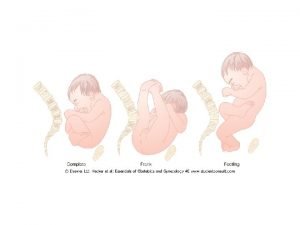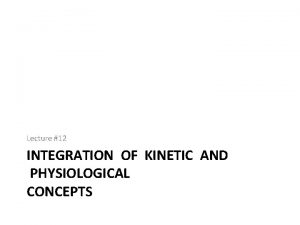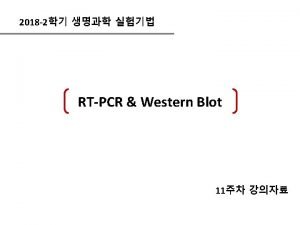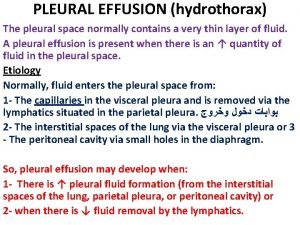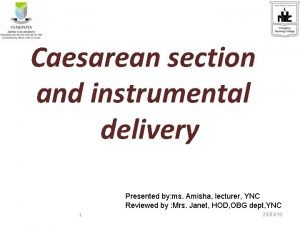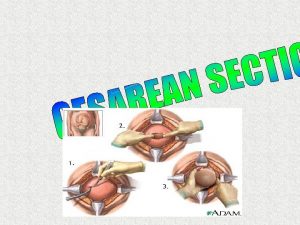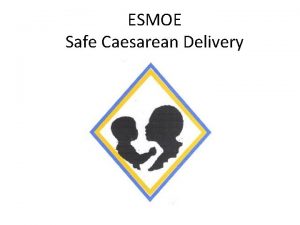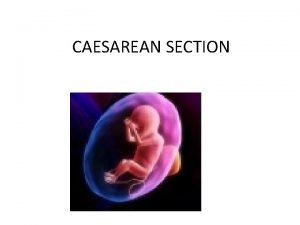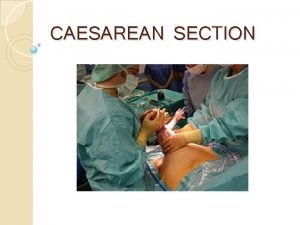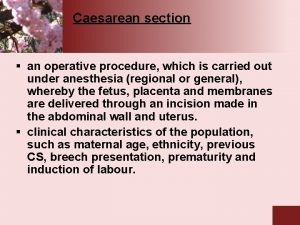Caesarean Section C S Definition Delivery extraction of

















































- Slides: 49

Caesarean Section (C. S. ) Definition: Delivery (extraction) of the fetus through an incision in the abdominal and uterine walls. The term C. S. fits to sections after 28 th week, while Hysterectomy describes section before 28 th week. Extraction of extra-uterine abdominal pregnancy or the fetus after uterine rupture is NOT a C. S.

Caesarean Section History: I. Origin of the term C. S. 1 - Lex Caesarea : Roman Law in 8 th century B. C. - No burial of dead pregnants before removing the child by abdominal section. 2 - Julius Caesar : Delivered by section. ? ? 3 - Caedere and Sec : Latin words meaning "to cut" in the middle ages. ? ?

Caesarean Section History: II. Evolution of Modern C. S. : First successful C. S. : on a living mother was at 16 th century – Uterine incision was not sutured. Modern classical C. S. : Sanger, 1882. First Lower segment C. S. : Kehrer, 1881. Modern LSCS: De Lee technique.

Caesarean Section C. S. Rate: Rising rates : (USA reports) 4 to 5% in 1960's 20 -24% in late 1980's Causes: repeat CS (35% of C. S. ) use of EFM widened fetal indications

Caesarean Section C. S. Rate: Stabilize C. S. rate: Promote trials for vaginal birth after C. S. (VBAC) Proper diagnosis and management of dystocia Proper interpretation of EFM

Caesarean Section C. S. Rate : Recommendations of A. C. O. G (1999) for VBAC : 1 - One or two prior low transverse C. S. 2 - Clinically adequate pelvis 3 - Strict labour monitoring and availability for emergency C. S. 4 - Availability of anaesthesia for emergency C. S.

Caesarean Section C. S. Rate : Factors affecting VBAC Type of prior uterine incision Number of prior C. S. Indication for prior C. S. Examination of previous scar.

Caesarean Section Indications: I. Absolute: No safe way for vaginal delivery even if fetus was dead – C. S. is a must: 1. Severe and absolute degrees of contracted pelvis: 2. 3. 4. 5. true conjugate < 5. 5 cm Soft tissue obstructing tumours: Cervical fibroid – Advanced cancer cervix Placenta previa centralis. Severe ant. and post. sacculation of the uterus. After successful repair of vesico-vaginal fistula.

Caesarean Section Indications : II. Relative : A- Maternal : 1 - Anterpartum Hemorrhage (abruptio placentae – placenta previa) 2 - Pelvic tumours 3 - Pelvic contraction (and malformations) 4 - Severe PIH – Eclampsia (selected cases) 5 - Maternal diseases: - Heart disease (e. g. tight mitral stenosis). Cerebral aneurysm Marfan’s syndrome Thrombocytopenia (ITP) (both maternal and fetal indication)

Caesarean Section Indications : II. Relative : B. Fetal : 1 - Abnormal presentations: deep transverse arrest (DTA), face, brow, breech, shoulder, complex 2 - Pulsating cord prolapse: most urgent indication 3 - Fetal distress: Abnormal EFM, Low scalp blood p. H, early thick meconium? 4 - Macrosomia: > 4. 5 Kg. 5 - Very Low Birth Weight (VLBW) infant: < 1. 5 Kg.

Caesarean Section Indications : II. Relative : B. Fetal : 6 - Fetal anomalies: Monsters, Fetal tumours 7 - Twin and multiple pregnancy: abnormal presentation of one or both twins 8 - Fetal jeopardy and IUGR: abnormal antepartum fetal surveillance tests (Low Biophysical profile score) 9 - Acute maternal genital HSV: in late pregnancy 10 - Post-mortem and Perimortem C. S. : save the baby within 8 -10 minutes

Caesarean Section Indications : II. Relative : C. Dysfunctional Labour (Dystocia): (30%) 1 - Abnormal uterine action: - Inertia (primary) - 2 ry arrest of progress - Retraction ring with impending rupture uterus 2 - Cephalopelvic disproportion: - C-P disproportion of fetal or maternal origin

Caesarean Section Indications : II. Relative : D. Bad Obstetric History: 1 - Previous C. S. : - Commonest indication (35%) Trial for VBAC Elective C. S. in > prev. 2 C. S. or permanent indications 2 - Recurrent pregnancy loss: - Habitual abortion IUFD & S. B. Neonatal death

Caesarean Section Types of C. S. I. Extraperitoneal C. S. : ◙ Indicated in potentially septic cases as PROM with chorio-amnionitis – Now obsolete in the era of antibiotics. 1 - Median approach 2 - Lateral approach

Caesarean Section Types of C. S. II. Upper Segment C. S. [Classical C. S. ] ◘ Vertical U. S. incision ◘ Now only indicated in selected cases: 1 - Extensive adhesions/varicosities of L. S. 2 - Severe pelvic outlet contraction with the head deeply engaged ? ? 3 - Preterm breech ? ? (For rapid or expedient extraction of the baby) ◘ Advantages and disadvantages

Caesarean Section Types of C. S. III. Lower Segment C. S. : A. LSCS – transverse incision: (Kerr) - The standard technique of LSCS B. LSCS – Vertical incision: (Kronig) Indicated in selected cases: 1. Contraction ring: (Cut across the ring) 2. Deeply engaged head ? ? 3. Anterior placenta previa ? ?

Caesarean Section Types of C. S. Elective C. S. : - Operation done before onset of labour. Emergency C. S. : - Operation done during the course of labour.

Caesarean Section Operative Technique : I. Abdominal Incisions: 1. Low Transverse incision 2. Lower mid-line (infarumbilical) 3. Left lower paramedian 4. Right paramedian for USCS Abdominal wall incisions for Caesarian section. The transverse incision is normally used for lower segment operations and the midline or paramedian for classic operations.

Caesarean Section Operative Technique : I. Abdominal Incisions: Types of Low Transverse incisions - Pfannenstiel incision - Joel Kohen incision - Maylard incision "muscle cutting“ - Cherney incision

Caesarean Section Operative Technique : II. Uterine Incisions: 1. LS transverse (standard) 2. LS vertical 3. US vertical 4. Inverted T-shaped incision Abdominal wall incisions for Caesarean section. The transverse incision is normally used for lower segment operations and the midline or paramedian for classic operations.

Caesarean Section Operative Technique: Incision of the peritoneum. The rectus sheath has been incised transversely and the rectus muscles separated. The peritoneum will be incised vertically in the midline.

Caesarean Section Operative Technique: Incision of the loose visceral peritoneum over the lower uterine segment.

Caesarean Section Operative Technique: Incision of the lower uterine segment in the midline, after inserting temporary stay sutures at the intended extremities of the uterine incision.

Caesarean Section Operative Technique: Extension of the lower segment incision laterally by muscle-splitting with the fingers, to reveal the bulging fetal membranes.

Caesarean Section Operative Technique : Application of obstetric forceps after rupturing the membranes. Forceps blade acts as vector (shoe horn).

Caesarean Section Operative Technique: Delivery by the breech. This is usually the easiest method of delivery when the fetus is lying transversely or obliquely, as well as when the breech presents.

Caesarean Section Operative Technique: Delivery of the placenta by cord traction.

Caesarean Section Operative Technique: Closure (repair) of uterine wound (incision): Technique: - Single-layer - Two layers Suture material: - Chromic cat gut Polyglycolic acid (Dexon) Polyglactin (Vicryl) PDS Vesico-uterine Peritoneum:

Caesarean Section Operative Technique: Closure of the uterine incision. Usually two layers of continuous sutures are adequate but additional interrupted sutures may be required to achieve local haemostasis.

Caesarean Section Mortality rate for C. S. : v Not exceeding 20 / 100, 000 C. S. (USA report) Morbidity rate : v Around 11%

Caesarean Section Complications: I. Intraoperative complications: 1 - Anaesthetic problems: e. g. aspiration “Mendelson's syndrome”. 2 - Difficult access to uterus or fetus 3 - Extension of uterine incision & lacerations of LS 4 - Difficult fetal extraction 5 - Fetal injuries 6 - Haemorrhage 7 - Bladder and ureteral injuries 8 - Bowel injury

Caesarean Section Complications: II. Postoperative complications: 1 - Post C. S. pyrexia 2 - Urinary tract infection 3 - Chest infection 4 - DVT – Pulmonary embolism 5 - Wound infection & dehiscence 6 - Ileus

Caesarean Section Complications: III. Late (remote) complications: 1 - Scar dehiscence and rupture - 0. 4% in LSCS - 4% in USCS 2 - Adhesions 3 - Abdominal incisional hernia

Peripartal Hysterectomy By Prof. Dr. Tawfik Abdel Salam Prof. of Ob/Gyn Alexandria University

Peripartal Hysterectomy: Implies removal of the uterus at or near the time of obstetric delivery. Includes: - Caesarean hysterectomy - Postpartum hysterectomy Evolved as the last resort to control life threatening obstetric haemorrhage and address the most distressing problems facing the Obstetrician.

Peripartal Hysterectomy Historical Perspectives: Development of peripartal hysterectomy can be divided into 4 historical era: 1. Early Explorations - Cavallini's idea (Italy, 1768) - Storer (Boston, 1868) 1 st Caesarean hysterectomy on a living patient

Peripartal Hysterectomy Historical Perspectives: 2. Porro Era: - First successful C. hysterectomy (Italy, 1876) 3. Expansionist Era: - Year 1900 onwards - Expansion of indications of peripartal hysterectomy: emergency, sterilization and gynecologic disorders. - In 1960's Obstetricians accept C. hysterectomy as part of routine obstetric training and practice.

Peripartal Hysterectomy Historical Perspectives: 4. Current era: - Literature of 1970 s and 1980 s continued controversy over elective C-hysterectomy. - Regional variations reflect differences of professional opinion and training experience.

Peripartal Hysterectomy Indications : A. Emergency indications: Life saving management of obstetric haemorrhage 1. Placental Disorders: - Placenta accreta (mainly previa accrete on previous scar) - Placenta previa + post-partum hge - Abruptio placentae + post-partum hge (Couvelaire uterus)

Peripartal Hysterectomy Indications: A. Emergency indications: 2. Uterine Rupture: - Previous scar (C. S. -myomectomy) - Spontaneous rupture 3. Post-partum Haemorrhage: (unresponsive to conservative measures) - Atonic - Traumatic: - uterine artery laceration at C. S. - Cervical lacerations

Peripartal Hysterectomy Indications: B. Indicated non-emergency cases: = planned (anticipated) C. hysterectomy 1 - Fibroids (± previous myomectomy) 2 - CIN 3 - Defective C. S. scar 4 - Chorio-amnionitis – sepsis 5 - Pelvic malignancies (invasive cervical cancer – ovarian cancer)

Peripartal Hysterectomy Indications: C. Elective indications: Controversial. Grand multiparity and "desired hysterectomy". Multiple repeat C. S. . Sterilization ?

Peripartal Hysterectomy Technique: Tourniquet technique Delayed Ligation technique (best method)

Peripartal Hysterectomy Black bars indicate three sites on each side of uterus where clamps must be placed to control the blood supply to the postpartum uterus.

Peripartal Hysterectomy Morbidity and Mortality Rates: Variable according to centre and indication. Overall mortality is around 70/10, 000 procedures. Mortality may be procedure-related or diseaserelated. Morbidity Rates: varies among centres from 20% (private) to 50% (training public centre)

Peripartal Hysterectomy Complications: A. Intra-Operative complications: 1. Haemorrhage: - Loss of control of uterine pedicle expanding broad ligament hematoma - Adnexal pedicle laceration Adnexal and retroperitoneal hematoma - "Back bleeding" from uncontrolled collateral vessels - Bleeding from cervical/vaginal stump

Peripartal Hysterectomy Complications: A. Intra-Operative complications: 2. Urinary tract injury: - Inadvertent cystotomy Ureteral injury (transection – ligation) 3. Bowel injury

Peripartal Hysterectomy Complications: B. Post-operative complications: Post-operative hemorrhage: � re-operation, internal iliac ligation, packing Wound complications: - Abdominal wall (abscess, seroma, hematoma) - Vaginal cuff (abscess, hematoma)

Peripartal Hysterectomy Complications: B. Post-operative complications: Urinary tract: - Vesico-vaginal fistula - Uretero-vagianl fistula Intestinal obstruction – bowel fistula – ileus Thromboembolism: DVT, pulmonary embolism Febrile morbidity.
 C section slideshare
C section slideshare Partial breech extraction
Partial breech extraction What is the website to access accenture delivery suite(ads
What is the website to access accenture delivery suite(ads Galenicals examples
Galenicals examples Ventouse chignon
Ventouse chignon Round off rule of 5
Round off rule of 5 Team and modular nursing
Team and modular nursing Forceps mnemonic for instrumental delivery
Forceps mnemonic for instrumental delivery Integrated care delivery system
Integrated care delivery system Service delivery process in it infrastructure
Service delivery process in it infrastructure It service delivery and support
It service delivery and support Delivery method definition
Delivery method definition Back door delivery
Back door delivery Health service delivery network
Health service delivery network Exodontia definition
Exodontia definition Hepatic extraction ratio
Hepatic extraction ratio Thar sfe
Thar sfe Strawberry dna extraction materials
Strawberry dna extraction materials Physical properties of metals
Physical properties of metals Indications of serial extraction
Indications of serial extraction Practical extraction and reporting language
Practical extraction and reporting language Water extraction montarra
Water extraction montarra Microwave assisted extraction
Microwave assisted extraction Hepatic extraction ratio
Hepatic extraction ratio Zones of liver
Zones of liver Extraction of metals
Extraction of metals Extraction de la chlorophylle à l'acétone
Extraction de la chlorophylle à l'acétone Glycomet 500
Glycomet 500 Contraindications for tooth extraction
Contraindications for tooth extraction Contraindication of tooth extraction
Contraindication of tooth extraction Hepatic extraction ratio
Hepatic extraction ratio Factor extraction
Factor extraction Penicillin
Penicillin Maxillary forceps
Maxillary forceps Easyblue
Easyblue Estrazione dna banana ppt
Estrazione dna banana ppt O2 extraction ratio
O2 extraction ratio Cobol data extraction
Cobol data extraction Hepatic extraction ratio formula
Hepatic extraction ratio formula Lever arm rule liquid-liquid extraction
Lever arm rule liquid-liquid extraction Bollman extractor working
Bollman extractor working Synthetic crude oil
Synthetic crude oil Spouted bed extraction
Spouted bed extraction Automatic wrappers for large scale web extraction
Automatic wrappers for large scale web extraction Automatic content extraction
Automatic content extraction Dna extraction
Dna extraction Burns marshall maneuver
Burns marshall maneuver Miller elevator uses
Miller elevator uses Loculated pleural effusion causes
Loculated pleural effusion causes Markables
Markables

